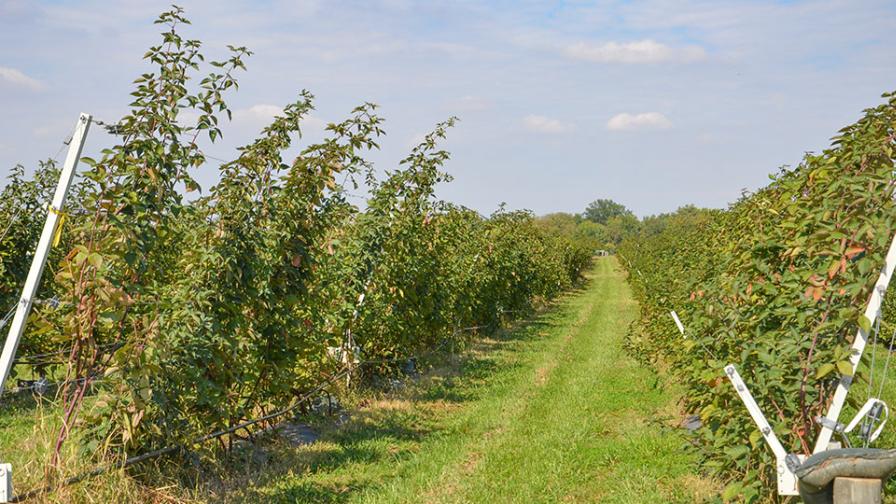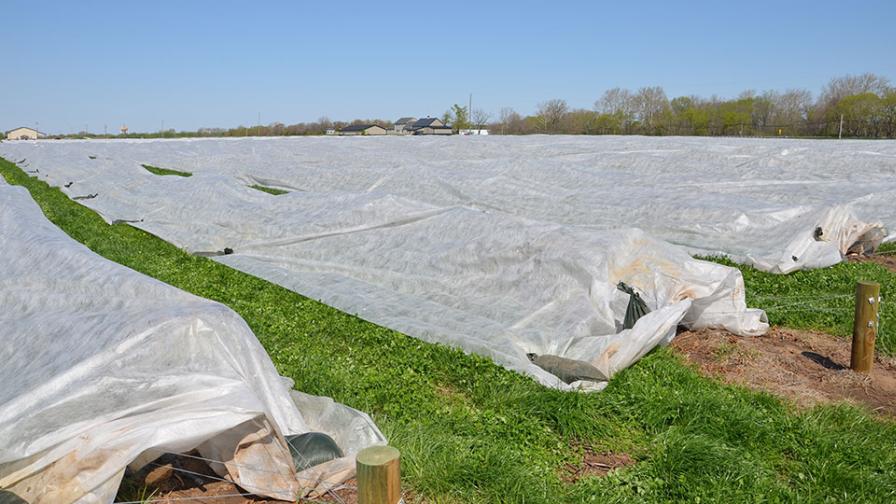Ways To Raise Your Game on Fall Care of Blackberries

Blackberry bushes growing on Rotatable Cross Arm Trellis system at Rhoads Farm in Circleville, OH.
Photo by Gary Gao
It is great to see that things are looking better and better in 2021 after a crazy spring and summer. Many of you should have just finished a great blackberry harvest season when this August issue of American Fruit Grower® magazine reaches you.
As you get your blackberry plants on the Rotatable Cross Arm (RCA) Trellis ready for winter, here are some helpful tips. Cutting the floricanes off, spraying fungicides, applying fertilizer, topping the laterals, flipping the trellises down and covering them with a row cover (if needed in your area), and applying rodent baits are some of the recommended tasks to get your blackberry bushes in the best possible shape for 2022.
For this article, I reached out to quite a few people. The first was my friend Brett Rhoads of Rhoads Farm in Circleville, OH. He has one of the largest blackberry plantings on RCA in the Midwest. Brett says his 2020 blackberry crop yield was very good, and fruit quality was exceptional due to Ohio’s drier weather in July and August. Based on what I saw at his farm, things are looking equally good in 2021. Brett also said that his crew typically finishes blackberry harvesting around Aug. 20 each year, the perfect marketing window for Midwestern blackberries.
Floricane Removal — Rhoads says his crew typically starts pruning off the floricanes a day or two after they finish harvest in late August. Removing the floricanes that fruited in 2021 should reduce fungal spore populations and help primocane growth. They also apply 5 to 10 pounds of nitrogen fertilizer to boost the growth of primocanes and the laterals. A word of caution for nitrogen fertilization: Do not wait until November. However, potassium fertilizer can still be applied then to help boost the plant’s winter hardiness.
Fungicide Applications — It is still critical to apply fungicide in fall to keep blackberry bushes healthy. Wesley Ebenhack, owner and Manager at Ebenhack Brothers LLC in Circleville, OH, strongly recommends both fungicide and fertilizer applications in fall. He was considering adding an application of foliar fertilizer in September because of a lack of growth in the primocanes this summer. This was in addition to the granular fertilizers he typically applies in fall. Rhoads also directs his crew to apply fungicides in fall. In addition, his crew will make a Sulforix application before they flip the trellis down and cover the plants with row covers in December.
Topping the Laterals — Richard Barnes of Trellis Growing Systems in Fort Wayne, IN recommends topping the laterals (to the top wire) using a power hedge trimmer during mid- to late fall. At the end of growing season, it is also important to remove ties holding the primocanes to the front training wire.
Rotating the Trellis Down — Early to mid-December is when blackberry growers in Ohio flip their RCA trellises down. According to Dr. Fumi Takeda of USDA ARS, whether or when to flip down the trellises is dependent on a farm’s USDA hardiness zone. In the Northern areas (USDA plant hardiness zones 7a and below), where low winter temperatures can injure blackberry plants, the long cross-arms are rotated toward the side with the short cross-arm in early winter. Ebenhack has his own routine.
“Maybe not recommended, but normally starting in late October to early November, I will start rotating the trellises in stages moving down one pinhole at a time,” he says. “This seems to result in less canes breaking.” If your USDA cold hardiness zone is above 7a, consider yourself lucky. You do not have to flip the trellises down until spring, when they need to be in the horizontal, or flowering, position.
Covering the Bushes — Blackberry growers in Ohio use row covers to keep the blackberry bushes from being injured from cold winter temperatures. Rhoads uses a 3-ounce floating row cover, which is laid down after the trellises are rotated down in December.

Blackberry bushes are covered with 3-ounce floating row cover at the Rhoads Farm in Circleville, OH.
Photo by Gary Gao
Placing Rodent Baits Underneath the Row Covers — Rodents can have a field day underneath the row covers in your blackberry planting during the winter months. They can chew on the canes and cause serious yield reduction. Rhoads uses rodent baits every year because the blackberry is such a high-value crop. He does not want to take a chance.
Blackberries are very popular among consumers. I often tell growers in Ohio that I would not grow blackberries in our state without some kind of winter protection. Rotatable cross arm trellis is such a beautiful invention. I am so glad that Takeda developed the system and Barnes commercialized it. Growers now have an effective way to grow great-tasting blackberries, and for a good profit, too!
It is always good to hear from our readers. I received an email from a grower in South Carolina last August. I gladly answered his question on a Sunday through email. Since climate and pesticide laws are different in each state, it is important to follow the pesticide label and consult your own Extension professionals for advice. I am sure they are as eager to help you as I am.










